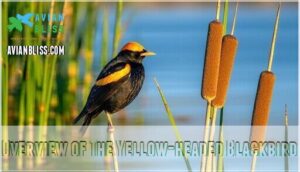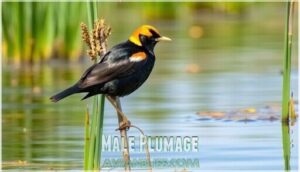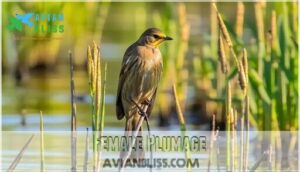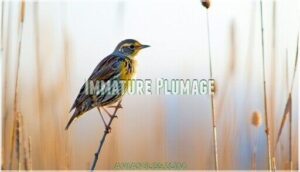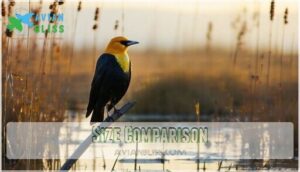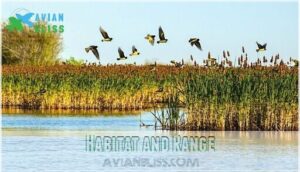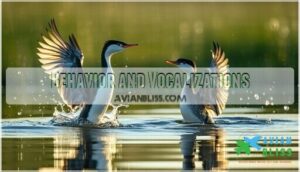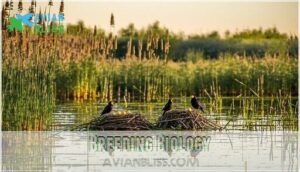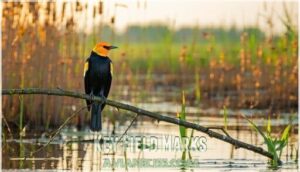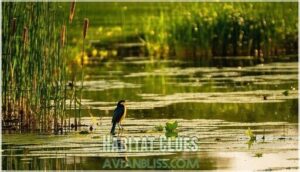This site is supported by our readers. We may earn a commission, at no cost to you, if you purchase through links.

These marsh specialists (Xanthocephalus xanthocephalus) inhabit cattail wetlands across western North America, where males perform dramatic courtship displays while females sport more subdued brown and yellow streaking.
They’re highly social, forming noisy colonies during breeding season with harsh, mechanical calls that echo across the water.
Unlike red-winged blackbirds, they prefer deeper marsh habitats and show striking sexual dimorphism.
During migration, massive flocks move between northern breeding grounds and southwestern wintering areas, sometimes creating agricultural challenges while also consuming beneficial insects.
Their distinctive appearance makes identification straightforward once you know what to look for.
Table Of Contents
- Key Takeaways
- Overview of The Yellow-headed Blackbird
- Physical Characteristics
- Habitat and Range
- Behavior and Vocalizations
- Diet and Feeding Habits
- Breeding Biology
- Migration Patterns
- Population Trends and Conservation Status
- Interactions With Humans
- Identification Tips
- Frequently Asked Questions (FAQs)
- How rare are yellow-headed blackbirds?
- Where can I find a yellow-headed blackbird?
- Is a yellow-headed blackbird the same as a yellow hooded blackbird?
- What does a female yellow-headed blackbird look like?
- Do they form long-term monogamous relationships with their mates?
- Are they known to engage in any unique mating rituals?
- Can they be found in urban areas or only rural ones?
- Are they considered a threatened or endangered species currently?
- How long do yellow-headed blackbirds live?
- Do they carry diseases to humans?
- Conclusion
Key Takeaways
- You’ll easily identify them by their striking golden-yellow heads and jet-black bodies – males display this dramatic contrast with white wing patches, while females show brown plumage with muted yellow facial markings.
- You’ll find them exclusively in freshwater marshes with cattails – they prefer deep-water wetlands (2-4 feet) across western North America and form noisy breeding colonies above the water line.
- You can observe their fascinating social behaviors during breeding season – males establish territories and attract up to five mates through elaborate courtship displays and harsh mechanical calls that echo across marshlands.
- You’ll witness their remarkable migration patterns between breeding and wintering grounds – massive flocks travel from northern marshes to southwestern agricultural areas, sometimes creating conflicts with farming operations.
Overview of The Yellow-headed Blackbird
You’ll find the yellow headed blackbird stands out as one of North America’s most distinctive blackbird species. This striking marsh dweller commands attention with its bold yellow head contrasting against sleek black plumage, making bird identification surprisingly straightforward.
Nature’s boldest blackbird flashes yellow against marsh cattails like a living sunburst.
The species thrives in freshwater wetlands across western and central regions, where males establish territories in cattail colonies while females construct intricate nests above water. These adaptable birds demonstrate remarkable species adaptation, shifting between aquatic breeding grounds and terrestrial foraging areas.
During bird migration, massive flocks converge in agricultural fields, creating spectacular wildlife displays. However, habitat loss threatens their traditional nesting sites as wetlands face increasing environmental impact from development and climate change.
Massive winter flocks transform quiet farmlands into bustling wildlife theaters across the Southwest.
Their conservation status reflects broader wetland ecosystem health, making them important indicators of environmental quality. Understanding these remarkable birds helps you appreciate the intricate connections between marsh habitats and wildlife survival in our changing landscape.
Physical Characteristics
You’ll quickly notice the Yellow-headed Blackbird‘s striking sexual dimorphism when identifying these marsh dwellers.
The species exhibits distinct plumage variations between males, females, and juveniles that make field identification straightforward with proper knowledge of their key features.
Male Plumage
A striking spectacle awaits you—the male Yellow-headed Blackbird’s glossy black body creates dramatic contrast against his brilliant yellow head.
His luminous black coloration extends across wings and tail, while distinctive white wing patches flash during flight.
The yellow heads display intense golden hues that shimmer in sunlight, making identification effortless.
Key male plumage features include:
- Jet-black body with metallic sheen covering back, wings, and underparts
- Bright yellow head and chest creating bold contrast with black plumage
- Prominent white wing patches visible during flight and aggressive displays
- Sharp, pointed beak shape perfectly adapted for marsh foraging and territorial defense
Female Plumage
Female Yellow-headed Blackbirds display striking sexual dimorphism through their brown coloration and distinctive facial markings.
You’ll notice their sooty brown bodies contrast beautifully with bright yellow face and chest feathers.
Unlike males, females lack prominent wing patterns but show white streaks across their belly, and their cone-shaped beak shape perfectly suits their varied diet.
Their subdued female plumage provides essential camouflage during nesting season in marsh environments.
Immature Plumage
Young yellow headed blackbird individuals display intermediate characteristics between juvenile and adult phases.
During the fledgling stage, immature plumage shows reduced yellow coloration compared to adults, with duller tones across head and chest regions.
Key immature plumage features include:
- Subdued yellow patches on head with brownish mixing
- Smaller white wing patches or complete absence in some individuals
- Streaked underparts with gray-brown base coloration
- Gradual color patterns developing through successive molts
- Variable plumage development timing between individual birds.
The molt process transforms juvenile feathers gradually.
Xanthocephalus xanthocephalus youngsters won’t achieve full adult breeding colors until their second year, making field identification challenging for birders.
Size Comparison
The yellow headed blackbird’s body length measures 8-10 inches, making it remarkably larger than its red-winged cousin but smaller than grackles.
These robust birds showcase impressive proportions that demand attention in any marsh setting.
Their substantial head shape and tail length create a stocky silhouette that’s unmistakable during size comparison observations.
- Body Length: Males reach 8-10 inches with females slightly smaller
- Wing Span: Impressive 15-17 inch wingspan for powerful flight
- Beak Size: Sharp, cone-shaped bill perfect for diverse foraging
Habitat and Range
You’ll find yellow-headed blackbirds across freshwater marshes from the Mississippi River westward, where they nest in cattail stands above water two to four feet deep.
During winter, these striking birds migrate to southwestern states, Mexico, and Central America, gathering in massive flocks across farm fields and open grasslands, which is a notable behavior of these yellow-headed blackbirds.
Freshwater Marshes
These wetland birds thrive in freshwater marshes with dense cattail stands and emergent vegetation.
Yellow headed blackbirds require aquatic plants and open water patches for ideal marsh ecology.
Colonies nest 2-4 feet above water, where water quality supports abundant insect prey.
Wetland conservation efforts focus on protecting these critical bird habitats from agricultural conversion and urban development, ensuring habitat restoration maintains suitable marsh conservation areas.
Open Fields and Pastures
Beyond marshes, yellow-headed blackbirds thrive in open fields and pastures during non-breeding seasons.
Their foraging habits involve walking through short grass, gleaning insects and seeds.
These open land use areas provide essential resources:
- Agricultural pest control through insect consumption
- Abundant seed sources from crops and weeds
- Migration stopover sites with ideal grazing patterns
Field ecology studies show these pasture management practices support stable populations across their habitat range, providing key benefits through agricultural pest control.
Breeding Grounds
You’ll find breeding grounds in freshwater marshes where yellow-headed blackbirds establish colony dynamics.
Males claim nesting sites through aggressive territorial behavior, defending prime marsh locations from competitors.
These migratory birds prefer marsh ecology with cattails standing in 2-4 feet of water.
Breeding habits involve polygamous males attracting multiple females within colonies that support wetland conservation efforts.
The success of these colonies depends on suitable bird habitat conditions.
Wintering Areas
After breeding season wraps up, Yellow-headed Blackbirds undertake remarkable journeys to winter habitats spanning from southwestern United States through Mexico.
Their migration patterns reveal fascinating flocking behavior as thousands gather in preferred wintering areas.
The birds’ social structure is characterized by large noisy colonies that form during breeding seasons.
- Agricultural fields and ranchlands – prime food sources with waste grain
- Large wetland roosting sites – essential for overnight protection and safety
- Mixed farmland-marsh mosaics – ideal winter habitats supporting conservation efforts
Behavior and Vocalizations
You’ll witness fascinating social behaviors when observing yellow-headed blackbirds in their marsh territories.
These highly social birds demonstrate complex communication patterns through their distinctive harsh calls and elaborate courtship rituals that help maintain colony structure and reproductive success, showcasing their elaborate courtship rituals.
Flocking Behavior
You’ll witness remarkable flock dynamics as yellow-headed blackbirds gather in massive colonial nesting groups.
During bird migration, thousands form cohesive flocks across the wetland landscape.
Their social structure creates impressive group foraging expeditions, while males coordinate colony defense strategies.
These migration patterns showcase sophisticated flocking behavior that helps them navigate seasonal movements efficiently through marshland territories.
Foraging Techniques
Yellow-headed Blackbirds demonstrate diverse foraging techniques across marsh and terrestrial environments.
These skilled hunters employ Ground Searching through vegetation, Seed Foraging in agricultural areas, and Insect Catching by gleaning from plant surfaces.
Their Flight Chasing abilities allow mid-air prey capture, while Aquatic Foraging targets emergent vegetation.
These feeding adaptations support their colonial nesting lifestyle, maximizing resource exploitation in both wetland and upland habitats throughout their range.
Courtship Displays
During breeding season, you’ll witness male Yellow-headed Blackbirds performing spectacular courtship displays to establish territorial defense and achieve mate attraction.
These male songs combine harsh calls with visual posturing as courtship rituals.
Males perch prominently while delivering loud vocalizations and visual signals, creating duets with interested females through intricate mating behaviors within their marsh territories.
Alarm Calls
Beyond their elaborate courtship rituals, male Yellowheaded Blackbirds serve as sentinels for their colonies.
When danger approaches, you’ll hear their distinctive Vocal Warning system spring into action. These Distress Calls coordinate the entire marsh community’s Threat Response, ensuring colony survival through effective communication.
Key alarm call functions:
- Predator Alert signals warn of approaching hawks, snakes, or other threats
- Flock Signals coordinate group movements during dangerous situations
- Territorial defense calls maintain colony boundaries against intruders
- Group dynamics coordination keeps the colony functioning as one unit
- Colony cohesion maintenance through constant vocal contact and bird vocalizations
Diet and Feeding Habits
You’ll find Yellow-headed Blackbirds switching between insect hunting and seed gathering throughout the year.
Their diet adapts seasonally, with protein-rich insects dominating during breeding season and seeds becoming more important during migration and winter months, which is a key aspect of their diet.
Insects and Arthropods
Yellow-headed Blackbirds hunt insects with remarkable precision.
These skilled predators target beetle species, caterpillar diets, and grasshopper habits through specialized foraging techniques.
Their arthropod diversity consumption supports wetland food web balance, effectively controlling insect populations.
| Prey Type | Hunting Method | Seasonal Peak |
|---|---|---|
| Beetles | Ground gleaning | Spring-Summer |
| Caterpillars | Vegetation picking | Late Summer |
| Grasshoppers | Aerial catching | Mid-Summer |
Seeds and Grains
Seeds and grains form the backbone of the Yellow-headed Blackbird’s diet, comprising roughly two-thirds of their total food intake.
Grain consumption peaks during fall and winter when insects become scarce.
Their seed preferences include sunflower seeds, wheat, corn, and various grass seeds.
These birds employ diverse foraging strategies, from ground-walking in agricultural fields to gleaning seeds from standing vegetation.
While their dietary needs are well-met by abundant grain sources, large flocks can cause crop damage in farming areas.
Seasonal Variations
Understanding Yellow-headed Blackbirds’ seasonal dietary shifts reveals fascinating migration patterns and breeding strategies.
Their feeding habits change dramatically throughout the year:
- Spring breeding seasons: Protein-rich insects dominate diets during nesting
- Summer abundance: Peak invertebrate consumption supports chick development
- Winter survival: Seeds and grains become primary food sources
These seasonal variations directly influence their timing of migration and wintering habits across diverse habitats.
The birds’ wetland habitat needs are essential for their survival and successful breeding.
Feeding Adaptations
You’ll find the yellow headed blackbird’s feeding adaptations remarkably versatile.
Their sharply pointed beak structure enables precise insect capture and efficient seed consumption throughout the year.
These foraging strategies demonstrate impressive dietary flexibility as birds switch from protein-rich insects and arthropods during breeding season to energy-dense seeds and grains in winter.
Whether gleaning from marsh vegetation or catching prey mid-flight, their foraging techniques showcase evolutionary perfection for wetland environments, highlighting their ability to thrive in such settings with impressive dietary flexibility.
Breeding Biology
You’ll discover that yellow-headed blackbirds create some of nature’s most fascinating colonial breeding systems in freshwater marshes.
Their complex nesting behaviors, from territory establishment to cooperative parental care, reveal remarkable adaptations for life in aquatic environments, showcasing remarkable adaptations.
Colonial Nesting
Yellow-headed blackbirds create bustling communities in freshwater marshes, where colonial nesting becomes a carefully orchestrated social affair.
Males establish territories within these colonies, defending prime real estate from competitors while attracting multiple mates through elaborate displays.
Their nesting habits reveal fascinating colony dynamics that maximize breeding success in aquatic environments.
- Territory establishment – Dominant males claim the best wetland locations, often displacing red-winged blackbirds
- Mate selection – Each male attracts up to five females through complex courtship rituals and vocalizations
- Nest defense – Coordinated colony responses protect against predators like hawks and snakes
- Breeding success – Colonial structure provides safety in numbers while reducing individual nest predation risks
Nest Construction
Female Yellow-headed Blackbirds craft their nests with remarkable precision using available marsh vegetation.
These skilled architects weave together cattails, sedges, and grasses to form deep, cup-shaped structures.
The nest construction process involves intertwining wet plant fibers that shrink and tighten as they dry, creating a remarkably secure foundation.
| Construction Element | Details |
|---|---|
| Primary Materials | Fresh cattail leaves and sedges |
| Weaving Technique | Wet fibers shrink when drying |
| Nest Depth | 3-4 inches deep for protection |
| Attachment Method | Firmly lashed to standing vegetation |
| Construction Time | 3-5 days of intensive building |
Egg Laying and Incubation
After the female constructs her sturdy nest, the egg laying and incubation phase begins in earnest.
She’ll produce a clutch size of typically 4 eggs, though you might observe anywhere from 3-5 pale gray to pale green specimens blotched with brown or gray markings.
The egg formation process occurs over several days, with one egg deposited daily until the clutch is complete.
The incubation period spans 11-13 days, during which the female maintains constant vigilance over her precious cargo.
She rarely leaves the nest except for brief feeding breaks.
The nesting materials she carefully wove earlier now provide vital insulation during this critical hatching process phase.
Here’s what makes their breeding biology fascinating:
- Temperature control: Females adjust their body position to regulate egg temperature precisely
- Predator awareness: They remain motionless when threats approach the nest area
- Weather adaptation: Rain and wind rarely deter dedicated incubating mothers
- Energy conservation: Females reduce metabolic rate during extended sitting periods
This intensive bird nesting strategy maximizes survival rates for developing embryos.
Parental Care
Once eggs hatch after egg laying and incubation, dedicated parental care begins immediately.
You’ll observe remarkable nest defense as both parents coordinate brood care duties.
Males provide essential fledgling support through territorial protection, while females focus intensively on chick rearing and feeding.
This parental investment continues for weeks after bird nesting, with young requiring extensive care even after leaving their nest construction site during breeding biology season.
Migration Patterns
You’ll witness one of nature’s most remarkable journeys as yellow-headed blackbirds travel thousands of miles between their breeding and wintering grounds.
These migrations reveal fascinating differences between males and females, with complex routes shaped by weather patterns and food availability, highlighting the incredible adaptability of these birds in their migrations.
Timing of Migration
Most Yellow-headed Blackbirds begin their spring migration between March and May, with males arriving on breeding grounds 1-3 weeks before females.
Peak movement occurs from early April through late May across central regions.
Fall departure starts mid-July through September, triggered by decreasing daylight and declining food sources.
These seasonal patterns create predictable flight schedules for observing their migratory patterns.
Routes and Stopover Sites
During migration, these birds follow established Flight Routes through the central flyway, making strategic stops at wetlands, agricultural fields, and marshes.
Stopover Sites provide essential refueling opportunities where they gather insects and seeds.
Migration Patterns include these key Travel Corridors:
- Prairie pothole region – Critical staging areas with abundant wetlands
- Agricultural valleys – Grain fields offering high-energy food sources
- River systems – Natural navigation aids with associated marshlands
- Coastal marshes – Final stopover points before reaching Wintering Areas
Differences Between Sexes
You’ll notice striking sexual dimorphism when observing these blackbirds during migration season.
Males and females exhibit distinct behavioral patterns that reflect their different roles and physical traits.
- Male Plumage Advantage: Males use their bright yellow heads and white wing patches to establish dominance during migration stops, securing better feeding spots through visual displays.
- Female Traits in Navigation: Females rely more on subtle coloration for camouflage while traveling, often moving in mixed-sex flocks where their brownish plumage provides protection.
- Sex Roles During Travel: Males typically arrive at breeding grounds first to claim territories, while females follow later to assess available nesting sites and potential mates.
- Mating Habits Influence: Color differences between sexes affect migration timing, with males needing extra energy to maintain their vibrant plumage throughout the journey.
Factors Influencing Migration
Weather patterns and food availability drive these blackbirds’ migration timing.
Spring storms can delay northward journeys, while drought affects insect abundance at stopover sites.
Climate change has shifted migration routes westward, forcing birds to adapt their traditional pathways.
Temperature fluctuations influence departure dates, with warmer falls extending breeding seasons and delaying winter movements to southwestern territories, influenced by climate change, temperature fluctuations, and warmer falls.
Population Trends and Conservation Status
You’ll find that Yellow-headed Blackbird populations have experienced significant fluctuations over the past century, with current trends showing both concerning declines in some regions and stable numbers in others.
Understanding these population dynamics is essential for protecting this striking marsh species and the wetland ecosystems they depend on, which is crucial for the conservation of this species.
Historical Population Changes
Yellow-headed Blackbird population trends reveal troubling patterns across North America.
Survey data shows modest declines between 1966-2019, with Minnesota reporting 1.86% annual population decreases since 1967.
Some regions experienced over 90% population drops.
Historical population changes reflect broader bird population dynamics affecting wetland species throughout the continent.
Understanding the bird conservation status is essential for developing effective conservation strategies.
- Wisconsin documented dynamic population shifts throughout the twentieth century, showing dramatic local variations
- Eastern range populations face steeper declines while western populations remain more stable
- Continental Concern Score of 9/20 indicates moderate conservation priority despite regional losses
Current Population Estimates
While conservation status remains stable globally, current population estimates show concerning population trends for yellow headed blackbirds.
Census data indicates the global bird population reaches approximately 11-15 million individuals, though estimate methods reveal regional declines.
Breeding Bird Survey data documents small but measurable decreases across North America between 1966-2019, with some states like Illinois listing the species as endangered due to significant local population drops.
Threats to Populations
Several significant threats to populations challenge Yellow-headed Blackbirds across their range.
Habitat Loss remains the primary concern, with over 87% of North American wetlands drained since the 1700s.
Climate Change alters wetland hydrology and breeding timing.
Human Disturbance from recreation and agriculture disrupts nesting colonies.
- Habitat Loss: Wetland drainage eliminates 87% of historical breeding sites
- Pollution Effects: Pesticide runoff reduces insect prey and causes bioaccumulation
- Climate Change: Drought cycles abandon traditional colonies for multiple years
- Fragmentation Impact: Isolated wetlands increase predation and reduce colony success
- Human Disturbance: Recreation and farming activities disrupt established breeding territories
Conservation Efforts
Protecting these striking marsh dwellers starts with habitat preservation in freshwater wetlands.
You’ll find bird conservation groups working tirelessly on wetland conservation, restoring degraded marshes and establishing protected areas.
Wildlife conservation organizations monitor breeding colonies, tracking population trends to guide ecosystem management decisions.
Species protection efforts focus on biodiversity restoration through collaborative partnerships between government agencies and local communities, ensuring Yellow-headed Blackbirds thrive for generations.
Interactions With Humans
You’ll likely encounter Yellow-headed Blackbirds if you live near wetlands in western North America, where they impact agriculture by consuming both crop pests and grain.
These striking marsh birds occasionally visit backyard feeders during migration, offering excellent opportunities for birdwatching and educational experiences about wetland conservation.
Agricultural Impacts
When you encounter Yellow-headed Blackbirds in agricultural landscapes, their relationship with farming creates complex challenges.
These striking marsh birds cause significant Crop Damage to sunflower and grain fields, with annual losses reaching $11 million across the northern Great Plains.
Agricultural impacts include:
- Farm Practices like pesticide use increase mortality and reduce insect prey availability
- Habitat loss from wetland drainage forces birds into closer contact with croplands
- Land Use conversion eliminates 85% of breeding wetlands in some states, threatening bird conservation efforts
To mitigate these effects, farmers often employ Bird Repellent Devices to protect their crops from damage.
Backyard Visitors
Most Yellow-headed Blackbirds won’t visit typical backyard bird feeders since they prefer wetland habitats over residential areas.
However, if you’re near marshes or agricultural zones, you might spot these striking yellow headed blackbird species passing through during migration.
Create appealing yard habitat by offering sunflower seeds at ground-level feeders and maintaining water features.
These garden visitors represent important urban wildlife, though backyard visitors remain uncommon.
Supporting bird conservation threats through native plantings helps preserve their marsh ecosystems while potentially attracting other backyard birds to your bird feeding stations.
Using the right bird feeder types can also enhance the attractiveness of your yard to various bird species.
Cultural Significance
Beyond your backyard, these striking birds carry deep cultural weight across communities. Their bold appearance weaves through human stories in meaningful ways.
- Native American folklore features Yellow-headed Blackbirds as messengers between worlds, their contrasting colors representing balance between light and darkness in tribal legends.
- Artistic depictions showcase their dramatic plumage in paintings and sculptures, with artists drawn to their visual impact and symbolic meaning.
- Literary references appear in poetry and prose, where writers use their harsh calls and striking appearance to represent untamed wilderness.
- Spiritual meaning connects their presence to transformation and change, their seasonal migrations symbolizing life’s cyclical nature.
Understanding bird aggression factors is essential for peaceful coexistence with these birds.
Educational Value
Yellow-headed blackbirds offer exceptional educational value through hands-on bird watching experiences and wildlife studies.
These striking marsh dwellers demonstrate conservation education principles while teaching environmental awareness through observable behaviors.
Learning strategies include field identification practice and habitat analysis, making yellow headed blackbird studies perfect for bird species identification skills and understanding bird conservation efforts.
| Educational Application | Learning Outcome | Target Audience |
|---|---|---|
| Field identification workshops | Species recognition skills | Beginning birders |
| Marsh ecosystem studies | Habitat conservation awareness | Students, naturalists |
| Migration tracking projects | Population monitoring techniques | Researchers, volunteers |
| Breeding behavior observation | Reproductive ecology understanding | Advanced birders |
| Conservation action planning | Wetland protection strategies | Community groups |
Identification Tips
Identifying yellow-headed blackbirds becomes straightforward once you know their distinctive field marks and preferred haunts.
You’ll spot males by their unmistakable bright yellow heads contrasting sharply with jet-black bodies, while females display more subdued brown plumage with muted yellow facial patches.
Key Field Marks
Spotting a yellow headed blackbird becomes easy once you know what to look for.
Males display a bright yellow head contrasting sharply with their glossy black body and distinctive white wing patches. The beak shape is sharply pointed, perfect for their marsh lifestyle.
Sexual dimorphism is obvious—females show brownish plumage patterns with duller head color and lack prominent wing bars. Their tail feathers appear square-tipped, helping distinguish them from similar species in wetland habitats.
Understanding the bird guide resources is essential for accurate identification.
Similar Species
When identifying this marsh dweller, you’ll encounter several similar species that can cause confusion.
Here’s your field guide to sorting them out:
- Red-winged Blackbird: Smaller with bright red shoulder patches instead of white wing markings
- Common Grackle: Larger overall with iridescent purple-black plumage and no yellow coloring
- Tricolored Blackbird: Features red shoulders with white borders, lacks the distinctive golden head
The Brown Thrasher and Eastern Phoebe won’t fool you—they’re completely different birds.
Focus on size, wing patches, and head color for quick identification.
Habitat Clues
Habitat identification relies on key environmental indicators that reveal Yellow-headed Blackbird presence.
These wetland specialists inhabit specific freshwater marshes where cattails dominate.
Understanding Marsh Ecology helps locate breeding colonies in Nesting Sites with water depths of 2-4 feet.
| Habitat Type | Key Features | Season |
|---|---|---|
| Breeding Marshes | Dense cattails, open water patches | Spring-Summer |
| Foraging Areas | Agricultural fields, pastures | Year-round |
| Winter Refuges | Southern wetlands, farm fields | Fall-Winter |
Wetland Conservation efforts protect these wetland ecosystems from habitat loss.
Habitat Fragmentation threatens Migration Routes, making marsh conservation critical.
Look for colonies where emergent vegetation meets open water in healthy wetlands.
Frequently Asked Questions (FAQs)
How rare are yellow-headed blackbirds?
Here’s your answer to the question about Yellow-headed Blackbird rarity:
Some scientists theorize that abundant species hide conservation concerns.
Actually, Yellow-headed Blackbirds aren’t rare—they’ve got 11 million birds globally and they’re classified as Least Concern with increasing numbers.
You’ll find them commonly in western marshes, and this abundance is a key factor in their conservation status.
Where can I find a yellow-headed blackbird?
You’ll find yellow-headed blackbirds nesting in freshwater marshes with tall cattails across the western and midwestern United States during breeding season, from Mississippi River westward through central Canada.
Is a yellow-headed blackbird the same as a yellow hooded blackbird?
Like comparing apples to oranges, these aren’t the same bird.
You’re looking at two distinct species: Yellow-headed Blackbirds (North American marsh dwellers) and Yellow-hooded Blackbirds (South American species with different habitats and behaviors).
What does a female yellow-headed blackbird look like?
Female yellow-headed blackbirds display brownish-gray plumage with duller yellow coloring on their faces and chests.
You’ll notice white streaks across their bellies, creating a muted appearance compared to males’ striking black-and-yellow contrast.
Do they form long-term monogamous relationships with their mates?
Like sailors switching ships mid-voyage, you’ll find these birds don’t stick with one partner.
Males maintain territories with up to five mates simultaneously during breeding season.
They’re polygamous, not monogamous, prioritizing reproductive success over long-term pair bonds in their marsh colonies.
Are they known to engage in any unique mating rituals?
Males perform elaborate courtship displays featuring distinctive songs, visual postures, and territorial dances to attract females.
You’ll observe them perching openly while singing harsh, hoarse notes despite their secretive marsh habitat preferences.
Can they be found in urban areas or only rural ones?
Urban populations rarely exceed 5% of total sightings.
You’ll typically find yellow-headed blackbirds in rural wetlands, agricultural fields, and marshes rather than cities.
Though they occasionally visit urban parks with suitable water features during migration.
Are they considered a threatened or endangered species currently?
Currently, you’re not classified as threatened or endangered species. Though habitat loss challenges your populations, you remain stable across most breeding ranges in western North America.
How long do yellow-headed blackbirds live?
You’ll witness your feathered friends thriving for approximately eleven years in the wild. Some exceptional specimens reach eighteen years, though the average life expectancy appears to be about 11 years.
Do they carry diseases to humans?
Disease worries, while understandable, aren’t always necessary.
Wild birds including blackbirds can carry zoonotic diseases that spread to humans, but direct transmission remains limited.
You’d typically need close contact through handling, droppings, or contaminated environments.
Most infections occur by inhaling dust from feathers or droppings.
Basic hygiene prevents issues and is a key factor in preventing the spread of disease, making close contact a significant risk factor.
Conclusion
Ready to master yellow headed blackbird identification? These striking marsh dwellers showcase nature’s dramatic sexual dimorphism while serving as excellent indicators of wetland health.
You’ll find these colonial nesters most easily during breeding season when their harsh calls echo across cattail stands.
The yellow headed blackbird’s distinctive plumage makes field identification straightforward once you know their preferred deep-water habitats.
Their seasonal movements between breeding and wintering grounds demonstrate remarkable navigational abilities, connecting diverse North American ecosystems through their annual cycles.
- https://naturalheritage.illinois.gov/content/dam/soi/en/web/naturalheritage/speciesconservation/speciesguidance/documents/yhb-conservation-guidance-final.pdf
- https://en.wikipedia.org/wiki/Yellow-headed_blackbird
- http://www.wisconsinbirds.org/plan/species/yhbl.htm
- https://www.allaboutbirds.org/guide/Yellow-headed_Blackbird/lifehistory
- https://www.eastsideaudubon.org/corvid-crier/2020/2/27/yellow-headed-blackbird

